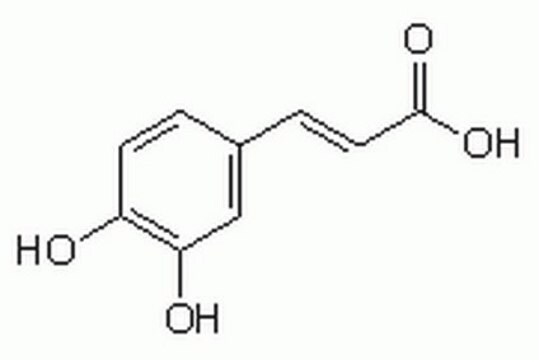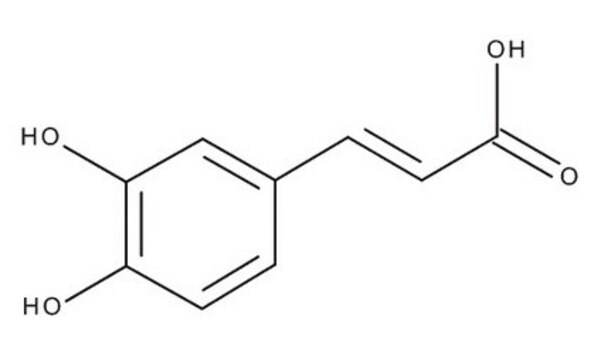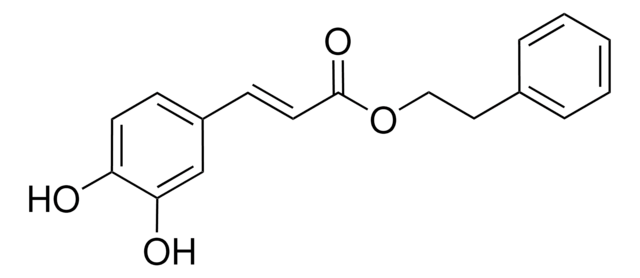60018
Caffeic acid
matrix substance for MALDI-MS, ≥99.0% (HPLC)
Synonyme(s) :
3,4-Dihydroxybenzeneacrylic acid, 3,4-Dihydroxycinnamic acid, 3-(3,4-Dihydroxyphenyl)-2-propenoic acid
About This Item
Produits recommandés
Qualité
matrix substance for MALDI-MS
Niveau de qualité
Pureté
≥99.0% (HPLC)
Forme
powder
Classe(s) chimique(s) de l'analyte
peptides, proteins
Technique(s)
MALDI-MS: suitable
Couleur
slightly beige
Pf
211-213 °C (dec.) (lit.)
Traces de cations
Ba: ≤5 mg/kg
Ca: ≤20 mg/kg
Cd: ≤5 mg/kg
Co: ≤5 mg/kg
Cr: ≤5 mg/kg
Cu: ≤5 mg/kg
Fe: ≤20 mg/kg
K: ≤50 mg/kg
Mg: ≤5 mg/kg
Mn: ≤5 mg/kg
Na: ≤50 mg/kg
Ni: ≤20 mg/kg
Pb: ≤5 mg/kg
Zn: ≤5 mg/kg
Adéquation
in accordance for UV test
Chaîne SMILES
OC(=O)\C=C\c1ccc(O)c(O)c1
InChI
1S/C9H8O4/c10-7-3-1-6(5-8(7)11)2-4-9(12)13/h1-5,10-11H,(H,12,13)/b4-2+
Clé InChI
QAIPRVGONGVQAS-DUXPYHPUSA-N
Vous recherchez des produits similaires ? Visite Guide de comparaison des produits
Description générale
Application
Actions biochimiques/physiologiques
Produit(s) apparenté(s)
Mention d'avertissement
Warning
Mentions de danger
Conseils de prudence
Classification des risques
Carc. 2
Code de la classe de stockage
11 - Combustible Solids
Classe de danger pour l'eau (WGK)
WGK 3
Point d'éclair (°F)
Not applicable
Point d'éclair (°C)
Not applicable
Équipement de protection individuelle
Eyeshields, Gloves, type P3 (EN 143) respirator cartridges
Faites votre choix parmi les versions les plus récentes :
Déjà en possession de ce produit ?
Retrouvez la documentation relative aux produits que vous avez récemment achetés dans la Bibliothèque de documents.
Les clients ont également consulté
Protocoles
HPLC Analysis of Polyphenols in Nero d'Avola Red Wine on Discovery® HS C18 (UV 280 nm)
Coumaric acid; Quercitrin; Myricetin; Quercetin
Notre équipe de scientifiques dispose d'une expérience dans tous les secteurs de la recherche, notamment en sciences de la vie, science des matériaux, synthèse chimique, chromatographie, analyse et dans de nombreux autres domaines..
Contacter notre Service technique








